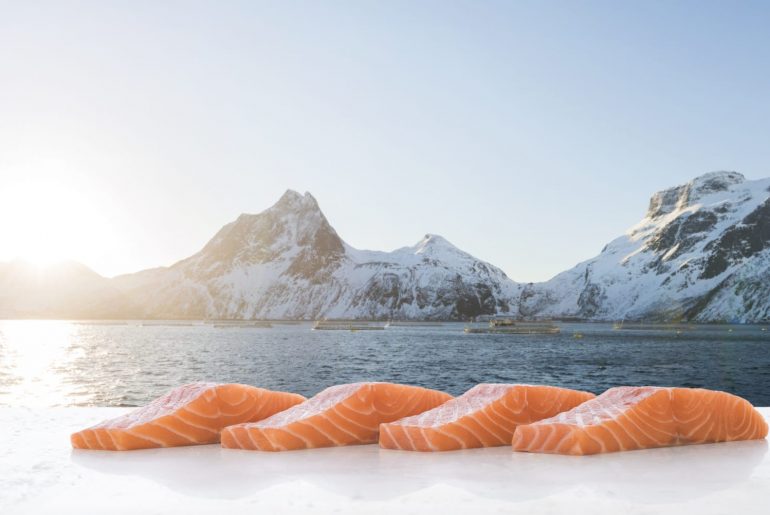The value of Norway´s seafood exports decreased by 16% or NOK 1.6 billion (approximately $185.8 million) to NOK 8.1 billion (about $941.5 million) in January of 2021 compared to the same month in 2020.
“The decline was primarily due to a significant fall in the export value of salmon. We also see a decline in exports of trout and fresh cod compared to the record month of January 2020,” said Tom-Jørgen Gangsø, the Norwegian Seafood Council’s (NSC) director of market insight and market access. He pointed to Covid-19 health crisis-related restrictions including closed and reduced capacity restaurants in many key markets as particularly challenging for the nation’s fishery product exporters.

“In sum, this means lower demand for a number of the most important seafood products from Norway. A small bright spot compared to the previous closure is that in many markets it seems that seafood counters in grocery chains are being kept open,” Gangsø.
Huge Drop for Salmon
Approximately 95,600 tons of salmon worth NOK 5.2 billion were exported in January. While this was an increase in export volume of 11 per cent, value fell by NOK 1.5 billion, or 23 per cent, compared with January last year.
Poland, France and the USA were the largest buyers of salmon from Norway in January, with the EU as a whole increasing its share of salmon exports from 64 per cent last year to 67 per cent this year.

“Despite a significant decline in value compared with January of 2020, salmon prices have remained relatively stable since August,” said Paul T. Aandahl, an NSC seafood analyst. “At that time, the average price was NOK 50.70 per kg. Compared with December, the price increased in January by NOK 1.04 per kg, or 2 per cent. Increased export volume and reduced sales to the restaurant sector are behind the relatively low price. Sweden was the largest growth market for salmon in January, measured in value.”
Sigmund Bjørgo, the NSC’s seafood envoy to Sweden, added: “After a weak December, where the market was saturated, it seems as if Swedish consumers have emptied their freezers and refrigerators of salmon during Christmas. January was a very strong month, with both high demand from consumers combined with attractive campaigns in stores.”

Decline for Trout
In January, 3,800 tons of trout worth NOK 218 million were exported, registering a 32 per cent decline. Value fell by NOK 134 million, or 38 per cent, compared with January of 2020. Ukraine, the USA, Poland and Belarus were the largest markets for Norwegian trout in January.
“Compared with fresh salmon, fresh trout has had a positive price development in recent months, and in January the price was 8 per cent higher for fresh whole trout. This is related to reduced volume compared to last year,” said Aandahl.
Growth for Clipfish
Upwards of 9,600 tons of clipfish worth NOK 438 million were exported in January, an increase of 12 per cent.
Value increased as well – up NOK 39 million, or 10 per cent, compared with January 2020. Brazil, Portugal and the Dominican Republic were the most important markets last month.
“The growth in January is due to increased volumes of clipfish of cod especially to Portugal, compared to relatively low volumes in January last year. Prices have fallen since January, but are still higher than in December 2020,” said Eivind Hestvik Brækkan, an NSC seafood analyst.

The export value of saithe clipfish increased by 2 per cent compared with January 2020. This is due to continuing positive market developments in the Dominican Republic.
“At the same time, there was a decline in exports of both cod and saithe clipfish to Brazil last month, due to a weak local currency against the US dollar and that the market is still strongly affected by the corona pandemic,” stated Brækkan.
Stockfish Exports Back on Track
Approximately 508 tons of stockfish, including fillets, were exported to generate receipts of NOK 92 million in January. The volume increased by 26 per cent while value rose NOK 13 million, or 16 per cent, compared with the same month last year. Italy, the USA and Nigeria were the biggest markets.
“After several months of decline in the Italian market, exports of stockfish increased in January, but several months of lower demand have resulted in significantly lower prices,” said Brækkan.
Trym Eidem Gundersen, the Norwegian Seafood Council’s seafood envoy to Italy, elaborated: “Italian society is gradually starting to open up more, which is positive for stockfish consumption and exports from Norway. It is first and foremost the low availability of stockfish as a result of the closures that is the reason for lower consumption.”
Fresh Cod Value and Volume Down
About 4,000 tons of fresh cod were exported in January, fetching receipts of NOK 182 million. This represents a decrease in volume of 34 per cent, while value fell by NOK 141 million, or 44 per cent, compared with the same month in 2020. Denmark, Sweden and Germany were the largest importers.
Skrei exports amounted to 409 tons, a decrease of 60 per cent compared with January last year. The value was put at NOK 25 million, a decrease of NOK 37 million, or 60 per cent.
“A late showing of cod and bad weather is the main explanation for the reduced fresh exports in January. At the same time, prices have fallen compared with a record-breaking January last year. This is due to a lower demand after almost a year with the corona virus pandemic and many closed restaurants,” explained Brækkan.
Growth for Frozen Cod
In January, 6,900 tons of frozen cod worth NOK 262 million were exported. This was an increase in volume of 35 per cent and a rise in value of NOK 28 million, or 12 per cent, compared with January last year. China, the United Kingdom and Lithuania were the largest recipients of frozen cod during the month.
“Growth must be seen in connection with an increased turnover of frozen whole cod first hand in December 2020. This is destined mainly for further processing in China and Eastern Europe,” said Brækkan.
Record Month for Mackerel
In January, 41,800 tons of mackerel worth NOK 626 million were exported, charting a volume increase of 57 per cent and a rise in value of NOK 187 million, or 43 per cent, compared with the first month of 2020. South Korea, Japan and China were the largest buyers of mackerel. 2020 was a record year for Norwegian mackerel, and 2021 also started strongly with a new January record for exports of the species
“We see that the strong demand from consumer markets such as South Korea, Taiwan and Japan continues,” said the NSC’s Jan Eirik Johnsen, who is responsible for pelagic species. “January has been a special month, as the Norwegian fleet has not had access to fish for mackerel in British waters. At the same time, we see that landings from foreign boats are increasing, which is partly because we have had an earlier start to the catching season than last year.”

Increased Availability of Small Herring
Approximately 28,100 tons of herring worth NOK 310 million were exported in January. The volume fell by 20 per cent as value declined by NOK 28 million, or 8 per cent, compared with the same month last year. Poland, Nigeria and the Netherlands were the most important markets.
“Herring exports have been characterized by the fact that a lot of small fish and not so many large herring have been caught. Large herring and MSC-approved fillet products get good prices in the market. On the other hand, we see that exports of whole frozen herring to, for example, Nigeria, are increasing at lower prices,” said Johnsen.
Decline in Prawn Exports
In January 881 tons of prawns worth NOK 66 million were exported. This was a reduction in volume of 3 per cent and a decline in value of NOK 8 million, or 11 per cent, compared with 2020 figures for the first month of the year. Sweden, the Netherlands and Finland were the largest markets in January of 2021.
King Crab Sales Solid in East Asia
Approximately 295 tons of king crab worth NOK 97 million were exported last month – up 27 per cent in volume and a gain of NOK 20 million, or 27 per cent, in value. South Korea, Hong Kong and Vietnam were the largest markets.
“Vietnam has had its best month ever for king crab. Although this is still a relatively small market, the trend of increasing volume and value that we saw in 2020 has continued into 2021,” said Ørjan Kjærvik Olsen, the NSC’s country manager for new markets.






